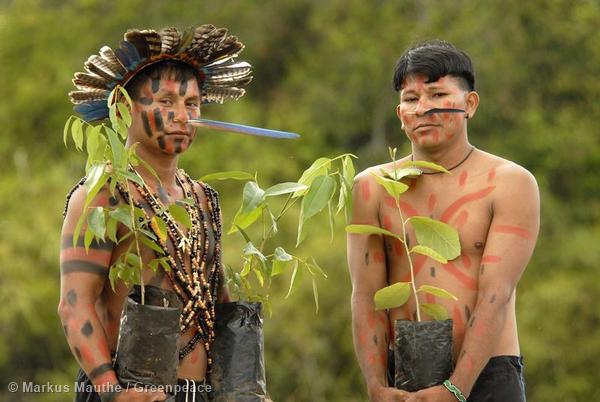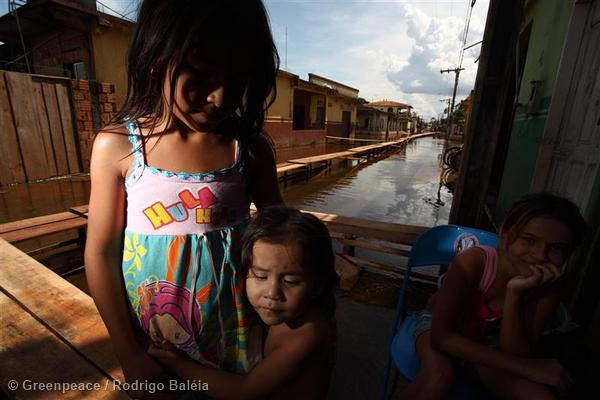Stopping deforestation and the destruction of the world’s rainforests is more than an environmental issue. It’s an everything issue.

Over the past few years, we’ve gained significant ground in getting major companies to move toward forest-friendly business models. You might think that means deforestation is beginning to be a thing of the past.
We want it to be. Unfortunately, threats to forests are only increasing. Just last year, the rate of deforestation in the Brazilian Amazon rose for the first time since 2008.

A barge loaded with timber in Para state. The top image of this post also depicts logging operations in Para.
Deforestation is not just an environmental issue. It’s an everything issue. Here are six reasons you can tell.
1. Forest loss is not decreasing. Although they still cover about 30% of the earths land area, we lose an area roughly equivalent to the size of Panama in forested land every year. At this rate, there wouldbe no forest left by around 2100. Even where forests are protected on paper, they arent protected in reality. Somewhere between 15 and 30% of the global trade in timber is harvested illegally. In countries where monitoring is difficult, up to 90% of timber exports are illegal. So yeah, its still going on.

A boy and two old women of a community of Baka people (pygmies) who live on the outskirts of Libongo, Cameroon.
2. Forests are home to 200 million people. An additional 1.4 billion people depend directly on forest goods for their survival. With practices of deforestation for products like palm oil, displacement of forest communities is rampant, and conflict between companies and communities has been very common. Deforestation threatens to deprive almost a quarter of the humans on the planet of their homes or livelihoods.
3.Biodiversity. Up to80% of terrestrial biodiversityi.e. a vast majority of all species of land plants and animalslives in forests. Deforestation and the destruction of forest habitat is the leading cause of extinction on the planet. Yes, climate change is making a big dent, but make no mistake, the direct clearing of forest is still the number one reason we are living in the sixth great extinction.
4. Climate change is in partcaused by forest loss which is in partcaused by climate change which is in part caused by forest loss. Trying to pull deforestation and climate change apart won’t work.Trees, forest plants, and forest soils store huge amounts of carbon. When forests are cut, this powerful carbon sink is rendered useless. Storedcarbon isreleased in the form of CO2 and methane. On top of that, the capacity of forests to pull greenhouse gases from the atmosphere is lost as forests are cut. Forest loss contributes about 15-20% of all annual greenhouse gas emissions. We really could go on and on.For now, heres a fun fact: the Amazon alone is one the vastest carbon stores in the world, containing ten times the annual global emissions of carbon from fossil fuels.

A network of access roads on former orangutan habitat that is now a palm oil concession in Indonesia.
5. Forests provide irreplaceable ecosystem, cultural, and economic functions, some of which we know, others we havent even discovered yet. In addition to storing all that carbon (and exchanging CO2 for the oxygen we breathe), forests play other vital roles that make life livable. They act as key guards against soil erosion, for instance, a fact made tragically clear by landslides like the one in Washington state last March, which many have arguedwereat least hastened by clear cutting.
Forests play a key role in the hydrological cycle by intercepting and regulating rainfall and flooding. They provide vital products that extend from food and shelter to medicines and other important social goods. Did we mention forests host a broad range of unique cultural groups and species found nowhere else? And forestshold value that exists beyond use by anybody or anything, just by their very nature as forests. We risk all of it as we let them decline.
6. Forestsrepresent a site of the widening gap between wealthy and poor. The great forests of the world exist in places where people are not wealthy. Most of the products that come from forests, however, are consumed far away from them, in the industrialized world. Over half of the worlds timber and almost three quarters of its paper is consumed by only about 20% of its population, mostly in the US, Europe, and Japan. The per capita consumption of wood products in industrialized countries outweighs that of non-industrializedcountries by a factor of twelve.

Manoki (Irantxe) indians in the State of Mato Grosso. The Manoki fight for their traditional land against the deforestation to make way for soya plantations.
Deforestation without the consent of local forest communities exacerbates social conflict and violence. Often, deforestation occurs in remote lawless areas and is accompanied by human rights violations. The cattle sector in Brazil and the Palm Oil sector in southeast Asia, both major drivers of deforestation, are also major sources of reported incidences of forced labor and social conflict.Deforestation often looks a lot like modern day colonialism.
The Brazilian Amazon is an iconic battleground of these conflicts. Already, an area about twice the size of Poland has been deforested in the Brazilian Amazon alone. In the past thirty years, about 18% of the Brazilian Amazon has been lost. A majority of this land has not been replaced by new forest but by pastureland for cattle.
Although deforestation has declined in Brazil over the last decade or so, the Brazilian government recently relaxed rules on deforestation and has limited the capacity of the federal environmental agencies that enforce those rules. Predictably, bad things followed. Between August 2012 and July 2013 deforestation increased by 28% compared with the previous year.
In the coming weeks, you can expect to hear a lot from us about deforestation and conflict in the Brazilian Amazon. You will also be hearing a lot from us about how you can contribute to battling deforestation.




